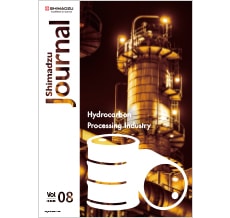Vol.8, Issue2-Jan 2021 CONTENT
Featuring Hydrocarbon Processing Industry
 |
Shimadzu Journal Vol.8, Issue2-Jan 2021 (10,380 KB) Hydrocarbon Processing Industry |
 |
[INSIGHT FROM CUSTOMER] Interview with Dr. Pan We interviewed Dr. Pan Yi, the deputy director of the Chemistry Research Division, National Institute of Measurement and Testing Technology (NIMTT). He uses our instruments at NIMTT on a daily basis. They established the "Gas analysis standardization and solution demonstration application laboratory" with Shimadzu.
|
 |
[INSIGHT FROM CUSTOMER]
Interview with Dr. Giusti and Dr. Piparo
We interviewed Dr. Pierre Giusti, the co-founder and scientific coordinator of the International Joint Laboratory i-C2MC (Complex Matrices Molecular Characterization), and Dr. Marco Piparo, the GC lab manager of the Molecular Separation and Identification team at Total Raffinage Chimie. We recently started collaborating on the development of a new kind of detector for oxygen speciation.
|
 |
[REPORT]
Reliable Sulphur Detection in Petrochemistry
In this study, using the example of diesel matrix, we investigated petrochemical samples via gas chromatography (GC) combined with Sulphur chemiluminescence detection (SCD).
|
 |
[REPORT]
Analytical method for determining aromatics and olefins in fuel as an alternative to FIA method. Aromatics and olefins in fuels are known to cause air pollution and generate harmful compounds in exhaust gases. FIA is typically used for this analysis. This article presents an alternative analytical method for determining aromatics and olefins in fuels.
|
 |
[REPORT]
Analysis of Sulfur in Fuels by Energy-Dispersive X-ray Fluorescence (EDXRF) The sulfur content of hydrocarbon fuels is regulated to limit atmospheric emission of sulfur oxides (SOx), which can cause negative health and environmental impacts. In 2020, new regulations from the International Maritime Organization (IMO) went into effect. In this article we used a Shimadzu EDX-7000 Energy Dispersive X-ray Fluorescence (EDXRF) spectrometer to establish compliance with common standard test methods, ASTM D4294 and ISO 8754, and to analyze a sample of marine fuel oil.
|
 |
[REPORT]
Applications of Frequency-Modulation Atomic Force Microscopes (FM-AFM) to Lubricant Frequency-modulation atomic force microscopes (FM-AFM) can capture the shape (XY) of solid surfaces in liquids and cross-sectional images (Z-X) of solid-liquid interfaces with high resolution. These instruments have gained attention with their use in a new method for clarifying the structure of lubricants at solid-liquid interfaces at the molecular level. In this article, we introduce two applications which use the Shimadzu SPM-8100FM (FM-AFM) to analyze lubricants.
|
 |
These articles were selected by Shimadzu. Relating to HPI analysis and development, these posters (from the Gulf Coast Conference 2019 and ASMS 2020) and application notes showcase a variety of instruments we produce and include cutting-edge technologies. Please obtain the articles of your interest through the links on the titles.
|
 |
[LATEST TOPICS]
Refinery gas is produced during crude oil refining. The gas is also used as petrochemical feed stock that is used in several catalytic processes. Determining the composition of refinery gas and measurement of trace sulfur content is very important. This article introduces trace sulfur detection using Shimadzu's highly sensitive Nexis SCD-2030, with results showing it to be a robust and accurate refinery gas analyzer.
|
 |
[LATEST TOPICS]
Tohoku University and Shimadzu Corporation have jointly developed a new breath test for detecting COVID-19. The technology termed ‘breathomics’ analyzes viral and host biomolecules contained in breath aerosols that can be collected by freely breathing into the newly-developed device for five minutes.
|
 |
[LATEST TOPICS]
Shimadzu Corporation announced a collaboration with the Clinical Laboratory and Proteomics Platform of the CHU University Hospital of Montpellier, France. Supported by a team of professors, Sylvain Lehmann and Christophe Hirtz focus on mass spectrometry-based blood amyloid-beta analysis for early screening of amyloid-positive subjects.
|
 |
[New Products] |



